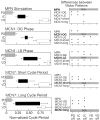Different proctolin neurons elicit distinct motor patterns from a multifunctional neuronal network
- PMID: 10377354
- PMCID: PMC6782314
- DOI: 10.1523/JNEUROSCI.19-13-05449.1999
Different proctolin neurons elicit distinct motor patterns from a multifunctional neuronal network
Abstract
Distinct motor patterns are selected from a multifunctional neuronal network by activation of different modulatory projection neurons. Subsets of these projection neurons can contain the same neuromodulator(s), yet little is known about the relative influence of such neurons on network activity. We have addressed this issue in the stomatogastric nervous system of the crab Cancer borealis. Within this system, there is a neuronal network in the stomatogastric ganglion (STG) that produces many versions of the pyloric and gastric mill rhythms. These different rhythms result from activation of different projection neurons that innervate the STG from neighboring ganglia and modulate STG network activity. Three pairs of these projection neurons contain the neuropeptide proctolin. These include the previously identified modulatory proctolin neuron and modulatory commissural neuron 1 (MCN1) and the newly identified modulatory commissural neuron 7 (MCN7). We document here that each of these neurons contains a unique complement of cotransmitters and that each of these neurons elicits a distinct version of the pyloric motor pattern. Moreover, only one of them (MCN1) also elicits a gastric mill rhythm. The MCN7-elicited pyloric rhythm includes a pivotal switch by one STG network neuron from playing a minor to a major role in motor pattern generation. Therefore, modulatory neurons that share a peptide transmitter can elicit distinct motor patterns from a common target network.
Figures









Similar articles
-
Projection neurons with shared cotransmitters elicit different motor patterns from the same neural circuit.J Neurosci. 2000 Dec 1;20(23):8943-53. doi: 10.1523/JNEUROSCI.20-23-08943.2000. J Neurosci. 2000. PMID: 11102505 Free PMC article.
-
Distinct functions for cotransmitters mediating motor pattern selection.J Neurosci. 1999 Aug 15;19(16):6774-83. doi: 10.1523/JNEUROSCI.19-16-06774.1999. J Neurosci. 1999. PMID: 10436035 Free PMC article.
-
Motor pattern selection via inhibition of parallel pathways.J Neurosci. 1997 Jul 1;17(13):4965-75. doi: 10.1523/JNEUROSCI.17-13-04965.1997. J Neurosci. 1997. PMID: 9185534 Free PMC article.
-
Frequency control of a slow oscillatory network by a fast rhythmic input: pyloric to gastric mill interactions in the crab stomatogastric nervous system.Ann N Y Acad Sci. 1998 Nov 16;860:226-38. doi: 10.1111/j.1749-6632.1998.tb09052.x. Ann N Y Acad Sci. 1998. PMID: 9928315 Review.
-
Basic principles for generating motor output in the stomatogastric ganglion.Ann N Y Acad Sci. 1998 Nov 16;860:35-50. doi: 10.1111/j.1749-6632.1998.tb09037.x. Ann N Y Acad Sci. 1998. PMID: 9928300 Review.
Cited by
-
Modulation of circuit feedback specifies motor circuit output.J Neurosci. 2012 Jul 4;32(27):9182-93. doi: 10.1523/JNEUROSCI.1461-12.2012. J Neurosci. 2012. PMID: 22764227 Free PMC article.
-
Convergent motor patterns from divergent circuits.J Neurosci. 2007 Jun 20;27(25):6664-74. doi: 10.1523/JNEUROSCI.0315-07.2007. J Neurosci. 2007. PMID: 17581953 Free PMC article.
-
Extrinsic modulation and motor pattern generation in a feeding network: a cellular study.J Neurosci. 2001 Mar 1;21(5):1767-78. doi: 10.1523/JNEUROSCI.21-05-01767.2001. J Neurosci. 2001. PMID: 11222666 Free PMC article.
-
Distribution and physiological effects of B-type allatostatins (myoinhibitory peptides, MIPs) in the stomatogastric nervous system of the crab Cancer borealis.J Comp Neurol. 2011 Sep 1;519(13):2658-76. doi: 10.1002/cne.22654. J Comp Neurol. 2011. PMID: 21491432 Free PMC article.
-
Intercircuit control via rhythmic regulation of projection neuron activity.J Neurosci. 2004 Aug 25;24(34):7455-63. doi: 10.1523/JNEUROSCI.1840-04.2004. J Neurosci. 2004. PMID: 15329392 Free PMC article.
References
-
- Aston-Jones G, Rajkowski J, Kubiak P, Valentino RJ, Shipley MT. Role of the locus coeruleus in emotional activation. Prog Brain Res. 1996;107:379–402. - PubMed
-
- Ayali A, Johnson BR, Harris-Warrick RM. Dopamine modulates graded and spike-evoked synaptic inhibition independently at single synapses in pyloric network of lobster. J Neurophysiol. 1998;79:2063–2069. - PubMed
-
- Beltz B, Eisen JS, Flamm R, Harris-Warrick RM, Hooper SL, Marder E. Serotonergic innervation and modulation of the stomatogastric ganglion of three decapod crustaceans (Panulirus interruptus, Homarus americanus and Cancer irroratus). J Exp Biol. 1984;109:35–54. - PubMed
Publication types
MeSH terms
Substances
Grants and funding
LinkOut - more resources
Full Text Sources
